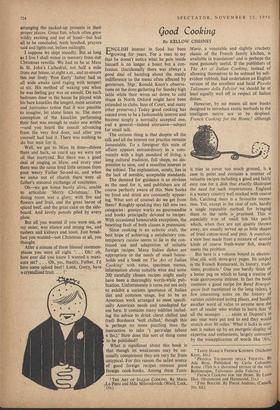good Cooking,
By KELLOW CHESNEY
ENGLISH interest in food has been
growing for - years. For a man to say that he doesn't notice what he puts inside himself is no longer a boast but a con- fession. (Incidentally there was always a good deal of humbug about the manly indifference to the menu often affected by gentlemen. Mgr. Ronald Knox's observa- tions on the dons gathering for Sunday high table while their wives sat down to cold shape in North Oxford might have been extended to clubs, Inns of Court, and many other preserves.) Today good cooking has ceased even to be a fashionable interest and become simply a normally accepted one, and a general—indeed obtrusive—subject for small talk.
The curious thing is that despite all the talk and all the interest our practice remains lamentable. To a foreigner this state of affairs appears extraordinary in a com- munity with a high standard of living, a long cultural tradition, full shops, no dis- position to save, and a manifest interest in the subject. The explanation, surely, lies in the lack of sensible, acceptable standards.
The demand for guidance is as obvious as the need for it, and publishers are of course perfectly aware of this. New books on food and drink are constantly appear- ing. What sort of counsel do we get from them? Roughly speaking they fall into two categories : gossipy works on gourmandise and books principally devoted to recipes. With occasional honourable exceptions, the besetting fault of both classes is pretension.
Since cooking is an eclectic craft, the best hope of achieving a satisfactory con- temporary cuisine seems to lie in the con- tinued use and adaptation of suitable foreign recipes. Many Italian dishes are appropriate to the needs of small house- holds and a book on The Art of Italian Cooking' with notes, specimen menus, information about suitable wine and some 200 carefully chosen recipes might easily have been a thoroughly worth-while pub- lication. Unfortunately it turns out not only to exhibit a curious ignorance of Italian diet and common usage, but to be an American work arranged to meet specifi- cally American needs and unadapted for use here. It contains many oddities includ- ing the advice to drink claret chilled and (red) Bordeaux 'well chilled,' though this is perhaps no more puzzling than the instruction to take '1 partridge (about 4 lbs.).' How does this sort of thing come to be published?
What is significant about this book is that though its weaknesses may be un- usually conspicuous they are very far from untypical. For this reason the safest source of good foreign recipes remains good foreign cook-books. Among these Tante
THE ART OF ITALIAN COOKING. By Maria .Lo Pinto and Milo Miloradovich. (Ward, Lock, 15s.) Marie, a venerable and slightly crochety classic of the French family kitchen, is available in translation2 and is perhaps the most genuinely useful. If the publishers of The Art of Italian Cooking, instead of allowing themselves to be seduced by self- evident rubbish, had undertaken an English version of the excellent and lucid Piccolo Talismano della Felicita3 we should be at least equally well off in respect of Italian dishes.
However, by no means all new books designed to introduce exotic methods to the intelligent native are to be despised. French Cooking for the Home,' although
it tries to cover too much ground, is a case in point and contains a number of valuable recipes including a good and fairly easy one for a dish that exactly illustrates the need for such importations. England is a watery country well stocked with coarse fish. Catching them is a favourite recrea- tion. Yet, except in the case of eels, hardly a single reputable method for bringing them , to the table is. practised. This is especially true of small fish like perch which, when they arc not quietly thrown away, are usually served up as little shapes of fried cotton-wool and pins. A matelote, a stew best made from a mixture of several kinds of coarse fresh-water fish, exactly meets the problem.
But here is a volume bound in electric- blue silk with dove-grey pages. Its subject is the French Restaurant, its history, tradi- tions, products.5 One can hardly think of a better peg on which to hang a treatise of wide gastronomic interest. In fact the book contains a good recipe for Bceuf B'ourgui- goon (not mentioned in the long index), a few interesting notes on the history of various celebrated eating places, and hardly another word of value to anyone save the sort of reader who wishes to learn that 'if all the sausages . . . eaten at Dupont's in one year were put end to end they would stretch over 80 miles.' What it lacks in con- tent it makes up by an energetic display of expertise and enthusiasm, largely conveyed by the misapplication of words like 'Art, TANTE MARIE'S FRENCH KITCHEN. (Nicholas Kaye, 16s.) 3 PICCOLO TALISMANO DELLA FELICITA. BY Ada Boni. Published by Carlo Colombo, Rome. (This is a shortened version of the vast, Beetonesque, Talisman° della Felicita.) 4 FRENCH COOKING FOR THE HOME. By Louis Diat. (Hammond and Hammond, 21s.) 4 FINE BOUCHE. By Pierre Andrieu. (Cassell. 31s. 6d.)
`Genius' and 'Glory' to skilful cookery. 1 mention this book because in both appearance and matter it suggests a most important impediment in the way of all culinary improvement. I mean the perverse' habit of mind which insists on speaking of cookery as if it were some mystery of almost religious significance, and seems to love costly, difficult and inappropriate dishes for their own sake. Very little real progress is likely while this way of thinking is current, and few gastronomic works published in this country seem altogether free of it. Per- haps, after all, pretension and gullibility will prove greater stumbling blocks than lethargy and indifference.











































































 Previous page
Previous page